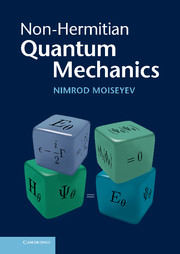Book contents
- Frontmatter
- Contents
- Preface
- 1 Different formulations of quantum mechanics
- 2 Resonance phenomena in nature
- 3 Resonances from Hermitian quantum-mechanical calculations
- 4 Resonances from non-Hermitian quantum mechanical calculations
- 5 Square integrable resonance wavefunctions
- 6 Bi-orthogonal product (c-product)
- 7 The properties of the non-Hermitian Hamiltonian
- 8 Non-Hermitian scattering theory
- 9 The self-orthogonality phenomenon
- 10 The point where QM branches into two formalisms
- Index
9 - The self-orthogonality phenomenon
Published online by Cambridge University Press: 03 May 2011
- Frontmatter
- Contents
- Preface
- 1 Different formulations of quantum mechanics
- 2 Resonance phenomena in nature
- 3 Resonances from Hermitian quantum-mechanical calculations
- 4 Resonances from non-Hermitian quantum mechanical calculations
- 5 Square integrable resonance wavefunctions
- 6 Bi-orthogonal product (c-product)
- 7 The properties of the non-Hermitian Hamiltonian
- 8 Non-Hermitian scattering theory
- 9 The self-orthogonality phenomenon
- 10 The point where QM branches into two formalisms
- Index
Summary
In the standard (Hermitian) formalism of quantum mechanics, usually when a potential parameter is varied the crossing of energy levels with the same symmetry is avoided. However, within the framework of the non-Hermitian formalism it is possible that two (or even more) complex eigenvalues with the same symmetry will cross. At the crossing point the eigenvalues are degenerate and this is accompanied by the coalescence of the eigenfunctions (or eigenvectors). Therefore, we may term this special situation as a non-Hermitian degeneracy. This special situation is associated with a branch point in the complex energy plane which is commonly termed an “exceptional point” in the spectrum of the non-Hermitian Hamiltonian. With respect to the c-product defined for non-Hermitian operators (matrices) in Chapter 6, the degenerate eigenstate is self-orthogonal. Since a branch point in the spectrum is removed by any infinitesimally small external perturbation, it seems to be inaccessible experimentally and may be considered just as a mathematical object rather than a physical one. However, as we will show here, by varying the potential parameters the existence of a branch point is reflected in the measurement of the geometrical phases also known as Berry phases. It should be stressed here that while in our case the geometrical phase results from a coalescence of eigenfunctions of a non-Hermitian Hamiltonian, the so-called Berry phase phenomenon occurs also within the Hermitian formalism of quantum mechanics when the eigenvalues of the molecular Hamiltonian in the Born–Oppenheimer approximation are degenerate for specific geometry of the poly-atomic molecule.
- Type
- Chapter
- Information
- Non-Hermitian Quantum Mechanics , pp. 323 - 374Publisher: Cambridge University PressPrint publication year: 2011
- 1
- Cited by



